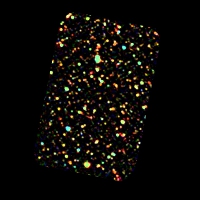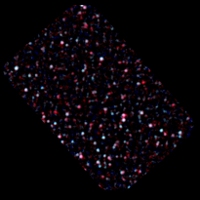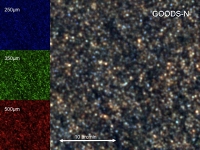Special issue of Astronomy & Astrophysics dedicated to Herschel's first results
16 July 2010
The first scientific results obtained with Herschel are appearing, this week, in a special issue of the journal Astronomy & Astrophysics. Based on data collected during the first few months of operations with this ESA observatory, the 152 new publications tackle a multitude of different astrophysical subjects, ranging from nearby Solar System bodies through newly-forming stars in our Galaxy, all the way to very distant galaxies. These first results provide a clear indication of the profound contribution that this mission will make to astronomy.It is harvest time for Herschel, ESA's infrared observatory launched just over a year ago, on 14 May 2009. A first batch of papers - 152 in all - are published in this week's special issue of Astronomy & Astrophysics. These are based on data collected during the first few months of scientific observations in late 2009 and early 2010.
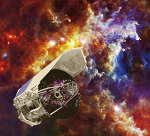 |
|
The Herschel spacecraft against the Rosette molecular cloud. |
Herschel observes the sky in the far-infrared and submillimetre domain of the electromagnetic spectrum, focussing on the emission from cold dust and gas in the interstellar medium (ISM) from two very different perspectives: nearby, within our own Galaxy where specific regions such as those where stars are still in the process of being formed can be studied in great detail; and far away, in very distant galaxies, whose light has been travelling towards us for thousands of millions of years, in some cases for over 10 thousand million years.
"These first, outstanding results cover an extremely rich variety of astronomical topics on all interesting cosmic scales: from objects in our own neighbourhood, the Solar System, to star-forming regions throughout our Milky Way galaxy and farther away, and even to distant galaxies and the very earliest phases of star formation in the Universe," explains Göran Pilbratt, Herschel Project Scientist.
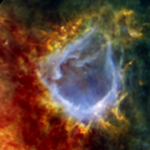 |
|
Young stars in RCW 120. |
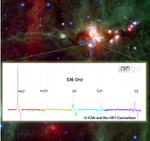 |
|
A HIFI spectrum reveals a number of key organic molecules. |
Great emphasis is also placed on the study of the interstellar medium, the mixture of gas and dust in the Milky Way from which stars are born and into which dying stars deposit chemically enriched material. By probing the chemical composition of the ISM to very high precision, Herschel provides astronomers with a brand new vista on the life cycle of matter in our own Galaxy.
From a cosmological perspective, Herschel is surveying the sky to a very great depth, revealing infrared emission from myriad faint and distant galaxies and demonstrating its capability to be a unique tool to probe the evolution of star-forming galaxies over several thousand million years of cosmic history.
The revolutionising impact that Herschel will have on these, and many more topics is clearly evident from the first papers, submitted by the end of March 2010 and collected in this week's special issue of Astronomy & Astrophysics. These first scientific results anticipate a wealth of remarkable results to be achieved during the coming years from this exceptional observatory.
"Albeit already impressive per se, this sample of publications is only the proverbial tip of the iceberg, and we eagerly await the multitude of results yet to come," says Pilbratt. "Thanks to Herschel, we are literally seeing what nobody has seen before," he adds.
Notes for editors:
Volume 518 (July-August 2010) of the journal Astronomy & Astrophysics is a special feature focussing on the first science results from the Herschel Space Observatory. The 152 articles in this issue give an overview of the results, as well as illustrating some of the highlights from Herschel's first year of operation. These results are based primarily on data obtained with PACS and SPIRE, two of Herschel's three instruments. Owing to an anomaly, the third instrument, HIFI, was unavailable from August 2009 to January 2010, and science with HIFI started in earnest in February 2010. A collection of papers dedicated to HIFI results will be published later this year.
Herschel is an ESA space observatory with science instruments provided by European-led Principal Investigator consortia, with important participation from NASA.
PACS is an imaging photometer and integral field line spectrometer covering wavelengths between 57 and 210 μm. PACS was built by a consortium of institutes and university departments from across Europe, and is led by Albrecht Poglitsch of the Max-Planck-Institute for Extraterrestrial Physics, Garching, Germany. Consortium members are: UVIE (Austria); KU Leuven, CSL, IMEC (Belgium); CEA, LAM (France); MPIA (Germany); INAF-IFSI/OAA/OAPD, LENS, SISSA (Italy); IAC (Spain). This development has been supported by the funding agencies BMVIT (Austria), ESA-PRODEX (Belgium), CEA/CNES (France), DLR (Germany), ASI/INAF (Italy), and CICYT/MCYT (Spain).
The SPIRE instrument comprises an imaging photometer (camera) and an imaging spectrometer. The camera operates in three wavelength bands centred on 250, 350 and 500 μm, and so can make images of the sky simultaneously in three submillimetre "colours". The spectrometer covers the range 200 – 670 μm, allowing the spectral features of atoms and molecules to be measured. SPIRE has been developed by a consortium of institutes led by Cardiff University (UK) and including Univ. Lethbridge (Canada); NAOC (China); CEA, LAM (France); IFSI, Univ. Padua (Italy); IAC (Spain); Stockholm Observatory (Sweden); Imperial College London, RAL, UCL-MSSL, UKATC, Univ. Sussex (UK); Caltech, JPL, NHSC, Univ. Colorado (USA). This development has been supported by national funding agencies: CSA (Canada); NAOC (China); CEA, CNES, CNRS (France); ASI (Italy); MCINN (Spain); SNSB (Sweden); STFC (UK); and NASA (USA). The consortium is led by Professor Matt Griffin of Cardiff University.
HIFI, a high resolution spectrometer, has been designed and built by a consortium of institutes and university departments from across Europe, Canada and the United States under the leadership of SRON Netherlands Institute for Space Research, Groningen, The Netherlands and with major contributions from Germany, France and the US. Consortium members are: Canada: CSA, U.Waterloo; France: CESR, LAB, LERMA, IRAM; Germany: KOSMA, MPIfR, MPS; Ireland, NUI Maynooth; Italy: ASI, IFSI-INAF, Osservatorio Astrofisico di Arcetri-INAF; Netherlands: SRON, TUD; Poland: CAMK, CBK; Spain: Observatorio Astronómico Nacional (IGN), Centro de Astrobiología (CSIC-INTA). Sweden: Chalmers University of Technology - MC2, RSS & GARD; Onsala Space Observatory; Swedish National Space Board, Stockholm University - Stockholm Observatory; Switzerland: ETH Zurich, FHNW; USA: Caltech, JPL, NHSC.
Related publications:
Astronomy & Astrophysics special feature: Herschel: the first science highlights, Volume 518, July-August 2010Contacts:
Göran Pilbratt, Herschel Project ScientistResearch & Scientific Support Department
Directorate of Science & Robotic Exploration, ESA, The Netherlands
Email: gpilbratt
 rssd.esa.int
rssd.esa.int Phone: +31 71 565 3621

